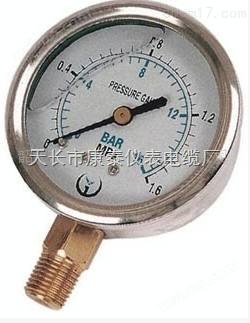 |
 |
 |
||||
Pressure gauge series |
Thermistor series |
Bimetallic thermometer series |
||||
YB anti-corrosion pressure gauge/stainless steel megapascal pressure gauge ordering pressure gauge:
1: Selection of dial size:
There are several options for the diameter of the pressure gauge dial: 40mm, 50mm, 60mm, 100mm, 150mm, 200mm, 250mm, 300mm, etc. There are also special specifications larger than 300mm, which can be used in specific situations. Customers are advised to choose the appropriate dial diameter according to their needs
2: Selection of pressure range:
The specifications of the pressure gauge are determined based on the pressure range. If the customer needs a pressure range of 0-0.6Mpa, they can only choose the corresponding pressure gauge. If they are unsure, they need to consult with customer service to determine if it is feasible. The conventional pressure range of pressure gauges includes 0-0.1, 0.16, 0.25, 0.4, 0.6, 1, 1.6, 2.5, 4, 6, 10, 16, 25, 40, 60, 100, etc. Vacuum gauges only have one pressure range, which is -0.1~0Mpa. There is also a vacuum pressure gauge with a pressure range from negative pressure to positive pressure, and its specific specifications are related to the specifications of -0.1~0.15, 0.3, 0.6, 0.9, 1.5, 2.5, 4, 6Mpa. There are also some ultra-high pressure gauges such as 200MPa and 300Mpa, and the diameter of these dials is generally above 150mm, which are used in special occasions.
3: Equipment of connectors:
The size of the pressure gauge connector varies depending on the size of the dial. Generally, the connectors for pressure gauges with a diameter of 60mm or less are M10 * 1, M13 * 1.5, and M14 * 1.5. The connector screws for dial diameters of 100 and 150 are M20 * 1.5. If there are no special requirements, we will default to this specification. Please confirm the specific specifications with customer service. If it is non-standard, additional fees will be charged for customization
4: Material selection for pressure gauge:
There are three types of materials for pressure gauges: 1. General pressure gauges, iron shell, copper core, and copper joint. 2. Stainless steel pressure gauge with stainless steel casing, copper core, and copper joint. 3. All stainless steel pressure gauge, stainless steel shell, stainless steel movement, and stainless steel joint. There is another type of laminated pressure gauge (micro pressure gauge, Kpa gauge) that generally uses an aluminum shell, a copper core, and a copper head
5: Selection of seismic conditions:
Pressure gauges are divided into general pressure gauges and shock resistant pressure gauges based on their seismic resistance. Shock resistant pressure gauges are filled with silicone oil (glycerin or nickel oil) and equipped with buffering devices. Their main characteristics include: mainly used for pressure detection in industrial sectors such as metallurgy, power, petroleum, chemical, light industry, and machinery. The pressure gauge relies on measures such as internal filling of damping oil and supporting buffering devices. Has good shock resistance performance. Suitable for situations where the pressure of the tested medium undergoes strong pulse changes or pressure shocks, and where there is frequent sudden unloading in the production process, as well as places with large environmental vibrations. The instrument can measure the average pulse pressure of gases and liquids to overcome the damage caused by strong medium pulses and environmental vibrations, ensuring the accuracy of readings.
6: Selection of installation direction:
Pressure gauges are divided into radial installation and axial installation. Radial installation refers to the installation where the dial is perpendicular to the ground; Axial installation refers to the installation of the dial and the ground in a horizontal state
7: Selection of different precision levels:
Most pressure gauges have an accuracy level of 2.5 and 1.6, with only precision gauges having an accuracy level of 0.4 or 0.25
8: Selection of Electric Contact Pressure Gauge:
Electric contact pressure gauges are suitable for measuring the pressure of various liquids, gases, and other media that are non corrosive, non explosive, and non crystalline to copper alloys. The instrument, when used in conjunction with corresponding electrical components, can achieve dual position automatic control and signaling (alarm) of the pre-set maximum or minimum pressure value for the measured pressure system. The instrument has measurement and control functions, and can set the upper and lower control pressure values arbitrarily. The action is stable and reliable, and it is widely used in industrial enterprises and electromechanical equipment such as petroleum, chemical, power stations, metallurgy, etc.
9: Selection of gas for pressure gauge:
The gas pressure gauge should be selected based on the type of gas used. For example, for oxygen, an oxygen pressure gauge must be selected, while for argon, only argon pressure can be selected. We will not give examples one by one
10. Transportation risk:
Pressure gauges are precision instruments. If they are subjected to excessive vibration or dropped on the ground during transportation, their appearance may not be easily damaged. However, the inside of the gauge may not return to zero or reset. Therefore, buyers must open the box and inspect the goods in front of the courier when receiving them. If there is any damage or if the gauge does not return to zero or reset, please do not sign for it! Please be sure to pay attention
More ProductsThis product * Sales:
Sales Specialist: Li
Sales website: www.ktybdl.. net :
Tianchang Kangtai Instrument Cable FactoryAdhering to the principle of "integrity-based, customer-oriented, and quality-oriented", we will continue to forge ahead, strive for excellence, and showcase our new strength and beautiful style today and in the future.

